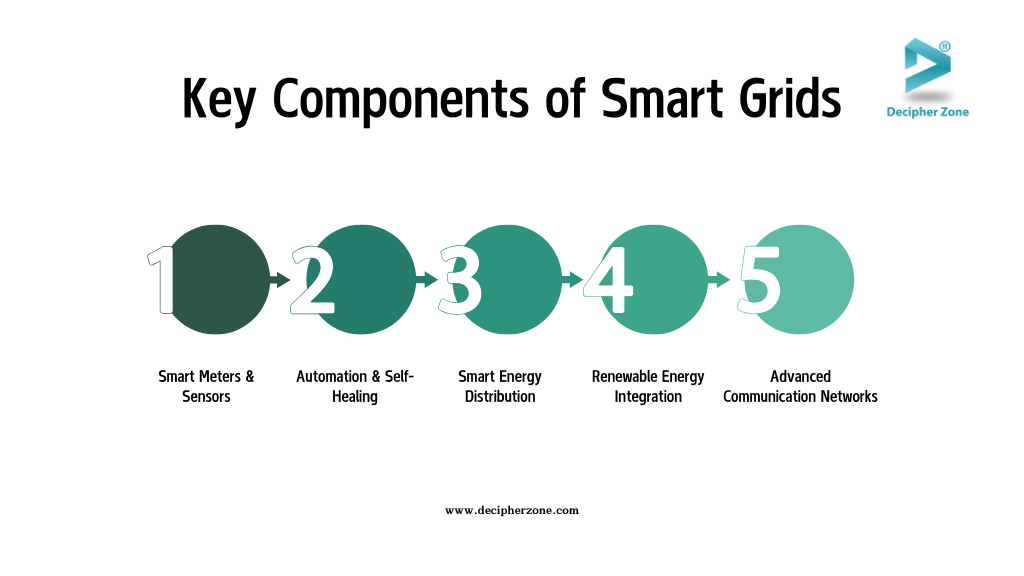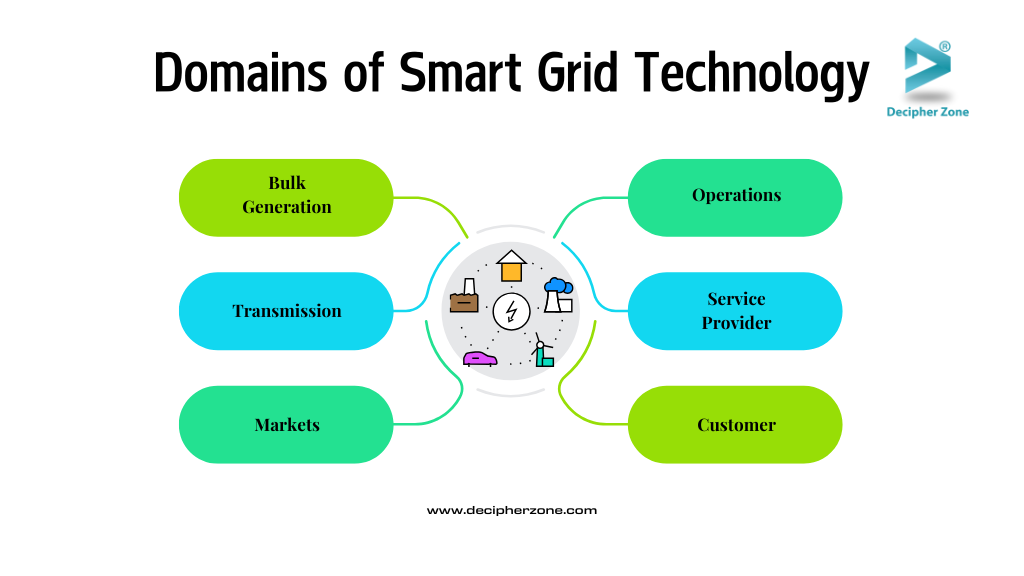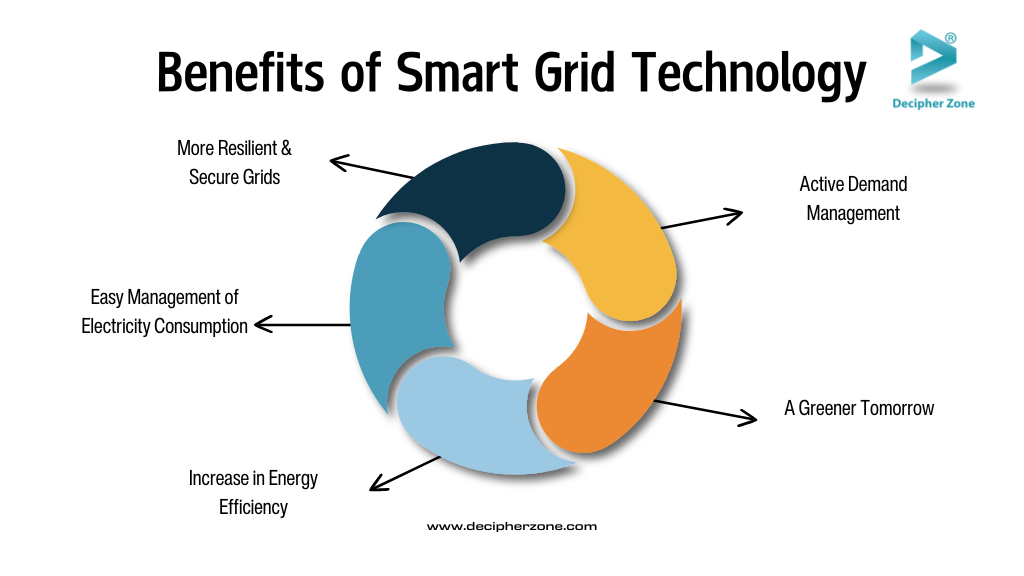Quick Summary: As sustainable energy continues to gain momentum in the market, investing in technologies such as smart grids appears to be a wise decision for the energy industry.
However, it is essential to understand what smart grids entail and the key components involved before making any investments. In this blog, we cover everything from the definition and scope of smart grids to the costs associated with smart grid software development to assist you in making informed decisions.
The growing threat of climate change and the increasing requirement for reliable electricity in our modern life have made sustainable energy more crucial than ever.
According to the United Nations Climate Change report, reducing pollution and climate impacts can save up to $4.2 trillion annually worldwide by 2030. And let’s accept the truth that the traditional power grid is old school now, functional but outdated.
That’s where Smart Grid Technology enters, revolutionizing how the energy flows.
Imagine a future where your energy needs are met seamlessly and sustainably. That's the vision of smart grids—innovative electricity networks that utilize the power of sensors and digital technologies to optimize energy production, demand, and supply.
These advanced systems are transforming how we think about electricity, from integrating renewable energy sources to safeguarding against blackouts.
But before we explore the exciting advantages of this transformative technology, let’s first understand how smart grids work and why they matter to businesses and consumers alike.
What is a Smart Grid Technology?
Smart grids are the upgraded version of the traditional power grids. Think of it like a smartphone that can track usage, connect to Wi-Fi, and optimize battery life. Smart grids are not just limited to delivering electricity, it’s about managing the energy flow more efficiently, sustainably, and intelligently.
By using technologies like sensors, automation, real-time data, and AI-driven analytics, smart grid technology can monitor energy consumption, predict demands, and prevent power outages before they happen.
While conventional power grids act as one-way streets delivering power to the home, the smart grid is a two-way highway communicating with smart meters, renewable energy sources, and electricity vehicles.
Information is transferred back and forth between network participants and sources to improve energy distribution and waste management.
How Does Smart Grid Technology Work?
Have you ever wondered how your Netflix streaming service never lags even when millions of people watch it simultaneously? That’s due to the smart data management system.
Now, imagine we apply that level of intelligence to energy distribution and consumption that’s what Smart Grid technology helps businesses achieve. As an automated, intelligent system, this technology balances energy supply and demand in real time.
Still a bit confused about the smart grid’s working? The functioning of the smart grid technology can be understood through its underlying components and principles. Let’s break them down for easy understanding.
Smart Meters & Sensors
Smart grids have smart meters that enable bidirectional communication between consumers and companies. The meters collect real-time data on energy consumption through sensors and send it back to the utility company for analysis, which refines power distribution based on the insights.
Automation & Self Healing
Automation is another essential component in the smart grid systems. Sensors integrated into power stations, homes, and businesses allow continuous grid monitoring for faulty connections, equipment failures, and voltage fluctuations through advanced algorithms and control systems.

Whenever a problem gets detected, the system quickly responds by isolating and rerouting from the faulty area to prevent power outages. Not only that, but the utilities also get a notification, allowing them to fix issues remotely if needed.
Smart Energy Distribution
While traditional power grids use a fixed power supply, which leads to power wastage and inefficiencies, smart grids dynamically adjust the supply based on real-time consumer demands.
They integrate a demand response program and AI-powered analytics, predicting when and where energy is needed and allowing power plants to ramp up or down energy production accordingly.
Renewable Energy Integration
Wind and solar are the fastest-growing renewable energy sources globally. With the increase in the adoption rate of renewable energy, many of these power plants integrate smart grids to optimize efficiency.
Smart grids are engineered to manage diverse energy sources effectively, predict weather patterns, store surplus energy, and adjust the energy supply according to demand.
This advanced infrastructure enhances the efficiency and reliability of energy distribution while supporting the transition to sustainable energy systems.
Advanced Communication Networks
The concept of a smart grid revolves around its capacity for real-time communication, enabling reliable and high-speed data transmission. Essentially, it functions like a high-speed internet network designed for electricity.
In this system, various devices—ranging from transformers and power plants to home appliances and smart meters—are interconnected, allowing for optimal energy usage through continuous data exchange.
This seamless communication relies on advanced networks, which serve as the foundational infrastructure of Smart Grid Technology.
Domains of Smart Grid Technology
Now that we have a better understanding of how smart grids work and the key components involved, it’s time to learn about the different domains, including Bulk Generation, Transmission, Markets, Operations, and Customers, of this technology that empowers its capabilities.
1. Bulk Generation
Smart Grid’s bulk generation domain is responsible for producing energy from both renewable (e.g. solar, hydro, geothermal, and wind) and non-renewable (e.g. nuclear, gas, and coal) sources in massive quantities.
Even the energy stored for later usage is a part of this domain. Besides that smart grid with its advanced monitoring and control systems helps improve the reliability, efficiency, and environmental performance of large power sources, which ultimately leads to a more balanced and responsive power distribution network.
2. Transmission
The transmission domain manages the high-voltage energy transfer from generation sites to the end consumers. The transmission network connects all the intelligent field devices and smart meters to manage and monitor two-way wireless and wired communication.
Smart grid technologies in this domain also help improve the reliability and capability of electricity transmission lines through dynamic line rating, real-time monitoring, and advanced fault detection systems, leading to minimal transmission losses and better integration of diverse energy sources.

3. Markets
The market domain plays a crucial role in overseeing, managing, and coordinating all participants involved in electricity trading within the smart grid system. It facilitates the wholesale, trading, management, and retailing of energy sources in a competitive market landscape.
Within this domain, the smart grid incorporates clearinghouse operations, energy information, and data exchange with third-party providers.
This leads to greater dynamism, the improvement of real-time pricing, the implementation of demand response programs, and the active participation of distributed energy resources, all of which promote efficient energy use and the integration of renewable resources.
Operations
The Operations domain is the powerhouse of the smart grid, managing and controlling the electricity flow across all other domains. It relies on a bi-directional communication network to connect substations, customer premises networks, and intelligent field devices seamlessly.
By utilizing real-time monitoring and reporting, it ensures grid stability, reliability, and efficiency. Business intelligence processes play a crucial role in gathering customer and network data, providing actionable insights for informed decision-making.
These insights help balance supply and demand, mitigate grid congestion, and swiftly address outages or faults.
Service Provider
The Service Provider domain acts as the bridge between consumers, utilities, and third-party operations within the Smart Grid ecosystem. It facilitates seamless communication and data exchange, enabling energy efficiency management, demand response programs, and outage management.
Using advanced technologies like real-time data analytics and Internet of Things (IoT) devices, it monitors energy flows, anticipates demand fluctuations, and detects anomalies, improving grid reliability and reducing operational costs.
Service providers also manage the complexities of bi-directional energy flows, ensuring that excess energy generated by consumers is efficiently fed back into the grid. This empowers consumers and contributes to a more sustainable energy landscape.
Customer
The customer domain represents end-users of electricity, ranging from residential households to large industrial consumers. In the Smart Grid framework, customers are empowered with tools and information to manage their energy consumption more effectively.
This includes access to real-time usage data, participation in demand response programs, and the ability to generate and store energy through distributed resources like rooftop solar panels.
Each of these domains plays a vital role in the Smart Grid's architecture, working collaboratively to create a more intelligent, efficient, and sustainable power system.
By employing advanced technologies and fostering integration across these areas, the Smart Grid aims to meet the evolving energy demands of modern society while minimizing environmental impact.
Case Studies and Projects
Explore cutting-edge solutions from our innovative projects, including Kaki Simulator, LeanSpace, SPEEDRENT, Symphony, and Tracc Solutions, each leveraging advanced technology to optimize energy management, streamline operations, and drive efficiency in smart grid systems.
Kaki Simulator
Tech Stack: Java, SpringBoot, Kafka, MongoDB, REST/JSON API, AWS EC2
Description: Kaki Simulator offers modern solutions for enterprise applications focusing on visualization and monitoring. Its platform can provide real-time insights into energy consumption patterns, making it relevant to industries working with energy grids or monitoring systems.
LeanSpace
Tech Stack: ElasticSearch, Spring Boot, Microservices, AWS, PostgreSQL, GraalVM, Kaitai-struct
Description: This project builds space software products for satellite operations, integrating and automating constellations. Space infrastructure solutions could have parallels in the energy sector, particularly in optimizing satellite or drone data for energy efficiency or smart grid applications.
Symphony
Tech Stack: Java, SpringBoot, SpringSecurity, Microservices, NoSQL-MongoDB, HBase, ZooKeeper, OAuth, Apache Kafka, Solr, Elastic Stack, REST, Docker
Description: Symphony focuses on secure, real-time communication for financial workflows. It can serve as a model for smart grid communication systems that require secure, scalable, and fast data exchanges for real-time energy distribution monitoring.
Tracc Solutions
Tech Stack: Angular 6, Javascript, HTML, CSS, Java, Jersey, Microservices, NoSQL-MongoDB, Jenkins, AWS EC2, S3
Description: Tracc Solutions focuses on business process management tools, which can be adapted to smart grids for optimizing grid performance, managing workflow automation for maintenance, and responding to energy demands in real-time.
Benefits of Using Smart Grid Software Solution
Incorporating smart grid technology in the electricity and energy industry offers several benefits to businesses, consumers, and power systems as follows:
1. More Resilient and Secure Grids
Traditional power grids are fragile and can easily suffer from equipment failures or cyberattacks, which may result in widespread blackouts. In contrast, smart grids are designed with self-healing and resilient features.
By integrating smart meters and sensors, smart grids can continuously monitor the system, detect issues, automate rerouting, prevent hacking attempts, and enable quicker energy restoration, among many other benefits.
Read: Renewable Energy Software Development
2. Easy Management of Electricity Consumption
Smart grid systems offer a dynamic and real-time window into energy consumption, empowering both consumers and businesses to actively oversee and fine-tune their electricity usage.
With this advanced capability at their fingertips, they can effortlessly adapt their energy applications to align with their specific needs, minimizing waste and maximizing efficiency.
This not only fosters a more sustainable approach to energy management but also cultivates a greater awareness of consumption patterns, ushering in an era of responsible energy stewardship.
3. Increase in Energy Efficiency
In contrast to traditional power grids, which operate on a rigid energy supply and often result in the excessive generation and wastage of energy, smart grids overcome this challenge by embracing flexibility and innovation.
These advanced systems excel in dynamically balancing loads, ensuring energy is distributed efficiently and responsively. They also adeptly prevent overloading and improve the entire grid's functionality through automated processes.

4. Active Demand Management
The integration of AI-driven prediction, interconnected smart devices, and dynamic demand response programs work simultaneously to seamlessly adapt to shifting energy needs in real time.
This powerful combination anticipates fluctuations with remarkable precision and allows for an agile response that aligns energy consumption with current demands.
5. A Greener Tomorrow
Smart grids are here to pave the way for a more sustainable future as they will help industries rely less on fossil fuels and more on renewable energy sources like wind, hydro, and solar power. This technology also empowers energy efficiency by enabling every consumer to get the most out of the resources they consume.
Cost of Developing Smart Grid Software
The cost of developing smart grid software varies significantly according to the grid size, system complexity, software features, team size, developers' experience, hardware integrations, professional services, licensing, and maintenance costs. To give you an estimation, smart grid software development can cost anywhere from $100,000 to $999,000+.
How Decipher Zone Can Help?
The smart grid has transformed from a mere vision of the future into a dynamic and evolving technology that is actively reshaping our energy landscape. It optimizes every facet of electricity—from its production to its distribution and consumption—creating a seamless, efficient network.
This innovative system promises to usher in a reliable and sustainable energy future, using modern technologies to guarantee that our power needs are met with precision and resilience.
If you're in the energy sector and looking to invest in smart grid software development to enhance your business operations and curb energy consumption, Decipher Zone is here to assist you.

Our team of experienced professionals will help you create an advanced software solution tailored to meet your specific business needs. So, stop waiting around and reach out to us today!
People May Ask
-
What is smart grid software?
Smart grid software consists of a collection of programs and digital applications that are designed to manage and enhance the flow of electricity within a smart grid. This software includes features such as demand response management, real-time monitoring, fault detection and isolation, renewable energy integration, asset management, and load balancing. These functions are powered by data collected and analyzed from various sensors and sources.
-
Why invest in smart grid software?
By investing in smart grid software, you as a business can take advantage of real-time data analysis, advanced algorithms, and more to improve grid efficiency, reduce energy waste, minimize operational costs, make data-driven decisions, comply with regulations, and manage changing demands.
-
What are the real-life use cases of smart grids?
Smart grid technology showcases its full potential through virtual power plants, electric vehicle (EV) integrations, and AI-driven renewable energy solutions. This technology allows businesses to provide a reliable power supply, balance energy demands, use EV batteries as temporary storage, and optimize wind and solar energy projects to support the power grid.

